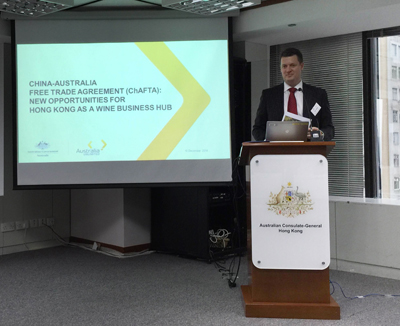What’s New
Edward Yu
Principal Assistant Secretary for Commerce and Economic Development
December 2014
Negotiations for the China-Australia Free Trade Agreement (CAFTA) were concluded in November 2014. The Agreement, on entry into force, would phase out tariffs for various Australian goods exported directly to Mainland China. For bottled wines from Australia, tariffs (currently 14%) would be removed over four years. While CAFTA would not be applicable to Hong Kong as a separate customs territory, the Australian Trade Commission here took an early focus at CAFTA business opportunities for Hong Kong through a wine industry seminar earlier this month.

Hong Kong re-exports more and more Australian wines to Mainland China. In 2012, 2013 and the first ten months of 2014, the value of such wines are HK$98 million, HK$137 million and HK$398 million respectively. They account for 5.6%, 8.6% and 21.5% of Hong Kong’s total wine re-exports in the respective period.
It is difficult to predict market changes at this stage when the implementation date of CAFTA is not yet announced. As observed by some participants of the seminar mentioned above, the effect of tariff savings should not be over-estimated. It is because of the retention of other import cost components such as Mainland’s value-added tax (17%) and consumption tax (10%). On the other hand, the costs of re-export through Hong Kong are already lowered considerably following our wine duty exemption. Our competitive advantage also lies in the reliable and efficient trading and logistics services we provide. Suppliers could still find it compelling to trade Australian wines through Hong Kong to the Mainland, particularly the provinces and municipalities near us.
For traders of higher-priced Australian wines with established trading channels through Hong Kong, they might stay put and would not export direct to the Mainland merely for the tariff savings – at least the incentive for them to change would be smaller before tariff is to be eliminated a couple of years down the road. Other brands could keep on relying on Hong Kong’s network in establishing a foothold in the Mainland. Some wines may no longer go through Hong Kong physically, but our traders can provide more off-shore services.
Many factors affect the choice of routing through Hong Kong or otherwise. FTA is but one consideration. Other factors include demand at the importing end and efficiency of ports. Without a crystal ball, we make reference to the experience of Chile (as another major wine source for the Mainland, which signed with China an FTA that came into effect in 2006). Tariffs on Chilean wine imports into the Mainland would be reduced, over ten years, to zero on 1 January 2015.
Hong Kong’s re-exports of Chilean wines to the Mainland is not arrested by the China-Chile FTA. The re-export value rather reached HK$29 million in 2013, some 6.7 times more than 2006. By volume, the annual average growth rate was 36% for the same period. The upward trend benefitted from a growing demand of Chilean wines on the Mainland as a result of the FTA (“spillover effect”). Hopefully Hong Kong would be similarly benefitted by CAFTA.
As opposed to re-exports, FTAs normally allow transhipment and transit of goods through a third party (e.g. Hong Kong) to enjoy tariff savings (provided that the goods in transit have not undergone trading nor manufacturing processing). With similar arrangements to be likely permitted under CAFTA, consignments of Australia wines could continue to be consolidated and re-packed at Hong Kong ports.